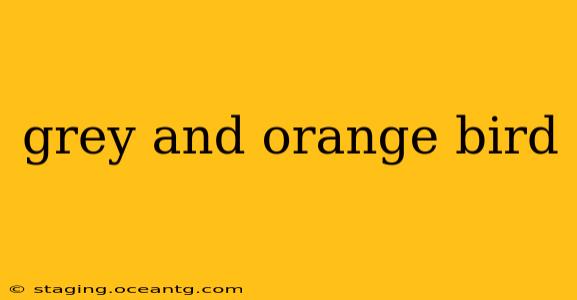Identifying birds can be a fun and rewarding hobby, but sometimes the subtle differences in plumage can be tricky. If you've spotted a grey and orange bird, you've got a fascinating puzzle on your hands! Many bird species incorporate these colors, often in striking combinations. This guide will help you narrow down the possibilities, covering a range of species and geographical locations.
What are some common grey and orange birds?
This question depends heavily on your location! Bird ranges vary considerably. However, some species commonly exhibit grey and orange coloring, including:
-
American Robin: While known for its reddish-orange breast, the American Robin also features a grey back and head, making it a prime example of a bird with both colors. This is a very common bird across North America.
-
Eastern Meadowlark: This bird displays a bright yellow-orange breast, contrasted by a grey back and wings. The distinctive melodic song also helps with identification.
-
Blackburnian Warbler: This warbler has a striking combination of grey and orange. The male has a fiery orange throat patch, a black cap, and grey sides.
-
Oranges and Greys in Tanagers: Several tanager species feature varying shades of grey and orange, though the specific shades and patterns differ considerably based on the subspecies. Geographic location is key to identification here.
-
Orange-breasted Trogon: Found in parts of Central and South America, this brilliantly coloured bird features a striking combination of grey and orange, as well as green and black.
What kind of grey and orange bird lives in [Specific Location]?
To answer this question accurately, we need to know your specific location! The species of birds found in a particular area can vary greatly. Providing your country, state/province, and even city will significantly improve the accuracy of identification. Online bird identification guides and forums, often specific to a region, can be invaluable tools.
What grey and orange bird has a long tail?
Several birds with grey and orange coloration might also have long tails. The length of the tail, combined with other identifying features like beak shape and body size, will help narrow down the possibilities. Again, location is critical. Consulting regional field guides is highly recommended.
Where can I find a field guide to help identify grey and orange birds?
Many excellent field guides exist, both physical books and online resources. Search for "bird identification guide [your region]" to find resources relevant to your area. These guides often feature detailed illustrations and descriptions to assist with identification.
How can I take better photos of birds to aid identification?
A clear photo is incredibly helpful in identifying birds. Try to capture:
- The entire bird: This helps to see the overall plumage pattern.
- Sharp detail: A clear image reveals details like beak shape, leg color, and wing markings.
- Natural lighting: Avoid harsh shadows or overly bright sunlight.
Using a good quality camera or even a smartphone with a decent zoom can significantly improve your chances of capturing a useful image.
Conclusion
Identifying birds requires patience and observation. By considering the specific location, size, shape, and other distinctive features, you'll be well on your way to pinpointing that grey and orange feathered friend. Remember, using regional field guides and online resources is crucial for accurate identification. Happy birding!
